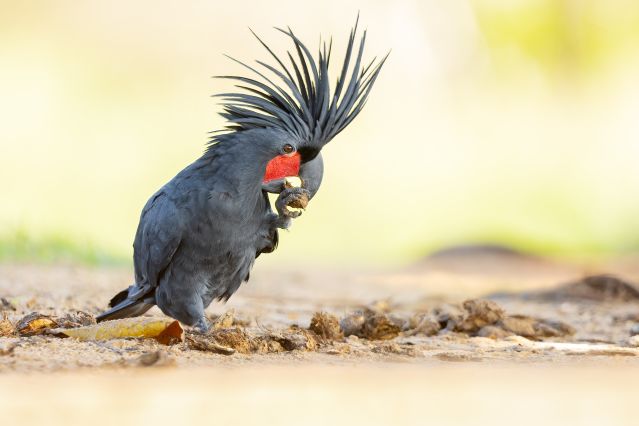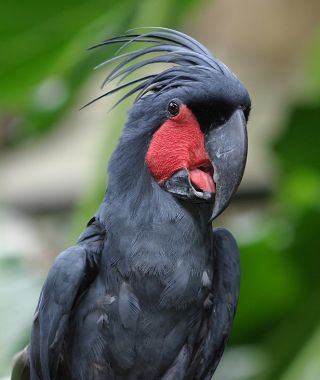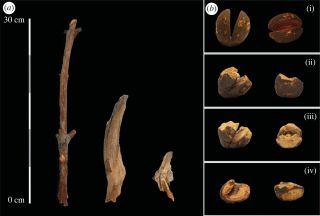Creativity
Custom-Made Drumsticks Showcase Cockatoo Creativity
How male palm cockatoos woo mates with individualized musical displays.
Posted September 20, 2023 Reviewed by Lybi Ma
Key points
- Male palm cockatoos make and use drumming instruments as part of their mating display.
- Individual birds differ in how they design and use their instruments and do not copy each other.
- Researchers suggest females may evaluate males on the individuality and creativity of their display.

It’s surprising that tool use isn’t more common among parrots in the wild. After all, parrots share several key traits with primates and other tool-using species, including large brains, complex social lives, and prolonged childhoods spent learning from their parents.
A fascinating exception is the palm cockatoo (Probosciger aterrimus), an endangered parrot native to parts of northern Australia and New Guinea. What makes them even more unusual is that they use tools as part of a musical mating display, rather than for foraging.
Now, a new study shows palm cockatoos craft individually distinct musical instruments for their displays according to their personal preferences. The findings suggest creativity may be valued by their mates.
Drumming Up Support
Male palm cockatoos perform elaborate displays for courtship and territorial defense. They erect their crests, spread their wings, and stomp their feet while cycling through a vocal repertoire of about 30 call types. Their bare cheeks flush crimson, contrasting with their jet-black feathers.

“The males bob and dance and twirl and carry on,” says Robert Heinsohn, a conservation biologist at Australian National University who has been studying these birds for nearly 20 years. “After they’ve done all that, they will waddle out to the end of a branch and they’ll snip off either a seed pod or a stick with their beaks.”
The female watches as the male breaks off a pod or branch and then whittles it down to his desired size and shape—crafting the tool is part of the display. When he is satisfied with his instrument, he grasps it (usually on the left foot) and beats it rhythmically against a tree limb or hollow.
Previously, Heinsohn and colleagues showed that male palm cockatoos drum to their own beats and that each male has his own distinct drumming signature, using different rhythms and flourishes. (Watch the video abstract).
“I can’t help but compare them to humans,” says Heinsohn. “It’s an independently evolved example of an animal that is effectively making a musical instrument.”
Style Is Substance
For the new study, Heinsohn and colleagues staked out 70 palm cockatoo display trees at their study site in Australia’s Kutini-Payamu National Park. Since the males usually toss their tools to the forest floor when their display is finished, the researchers were able to collect 256 instruments discarded by the birds (227 sticks and 29 seed pods).

Back at the lab, the researchers analyzed the tools. They found that the design of the tools themselves is a further highly individualized part of the birds’ display. In addition to some individuals favoring one type of tool, the analyses showed individual consistency in drumstick design: Some males preferred short and stubby drumsticks, while others crafted longer, thinner ones. What’s more, the researchers did not find any evidence that neighboring males copied each other.
“It was remarkable how individually distinctive the tools were, how the males all had their own styles,” says Heinsohn. “We think it demonstrates creativity, a sort of artistic side of their personalities and behavior.”
Questions remain about what female cockatoos think about these performances. But the fact that females watch all parts of the display closely—including the choice and manufacturing of the instrument—suggests to Heinsohn that they may value individuality in a mate.
“I think these birds are like human artists or musicians, in that they express a lot of creativity and individuality, and that seems to be selected for as much as the sum of the skill itself,” he says.
“There appear to be many ways that a male palm cockatoo can get this display right and please a female. Individuality and artistic expression seem to be a part of what the females are looking for.”

References
Heinsohn R, Zdenek CN, Appleby D, and Endler JA. Individual preferences for sound tool design in a parrot. Proceedings of the Royal Society B. Published online September 13, 2023. doi: 10.1098/rspb.2023.1271.
Heinsohn R, Zdenek C, Cunningham R, Endler J, Langmore N (2017). Tool-assisted rhythmic drumming in palm cockatoos shares key elements of human instrumental music. Science Advances vol. 3, no. 6, e1602399.


